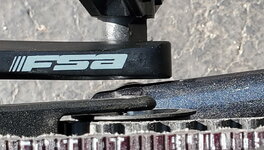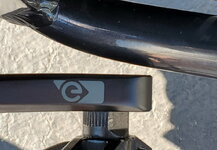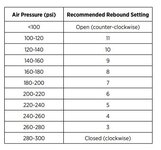I am interested in 160mm cranks replacements in the UK. Is there a specification and are they easy to replace on the Homage?
The crank arms are very easy to replace, as long as you have self-extracting crank bolts or the proper crank-arm puller tool.
(In the comparison photos below, you can see the self-extracting crank bolts I am using on my bike.)
Bosch Gen-4 motor crank shafts use an industry standardized ISIS spline, with a M15 center thread for the securing bolt.
(for the FSA cranks I own, the outer caps for the self-extracting crank screws are a M22 thread size. Other brands may be different.)
--------------------
Here are photos of the stock R&M 170mm crank arm alongside the 160mm & 155mm sets that I have bought and tried on my 2021 Homage.
You can see from the photo of the backside of the arms that R&M is simply painting their name onto FSA brand cranks.
In the case of my bike, the stock cranks are the CK-745/IS model in 170mm.
The 170mm stock R&M cranks are FSA model CK-745/IS cranks in forged 6061-T6 aluminum, and are offered in only three lengths: 165/170/175mm.
My 160mm cranks are FSA model CK-761/IS/wider, which are listed as also being forged and offered in four lengths of: 160/165/170/175mm.
The 155mm cranks are FSA model CK-220/IS, which are listed as diecast aluminum and offered in five lengths of: 155/160/165/170/175mm.
Looking at the way the pedal mounting holes are positioned on each crank arm above, it appears that FSA uses a single size of arm casting/forging for at least 2-3 different crank lengths, and just adjusts the distance the pedal hole is drilled for each model.
Which would explain why the stock crank arms look like they are longer than they need to be, the same forging can also be drilled for the 175mm part number.
I also find it curious that the two models of FSA cranks I have bought in different lengths both have the E-spec symbol cast or forged into the arms, but not on the ones supplied to R&M.
---------------------------------------------------------------------------------------------------------------
For fit and ergonomics, the relevant Q-factor measurements on the three sizes/models pictured are:
---------------------------------------------------------------------------------------------------------------
The measurement from the rear of the crank mounting flange to the face where the pedals thread against:
(Outer Width or "Crank Q-Factor" as shown in the illustration)
CK-745/IS (stock)= 39.2mm
CK-761/IS/wider = 39.8mm
CK-220/IS = 31.9mm
The measurement from the rear face of the crank mounting flange to the rear face at the outer end of the crank arms (for chainstay clearance):
(Inner Width or "Crank Chainstay Clearance Width")
CK-745/IS (stock)= 25.8mm
CK-761/IS/wider = 26.5mm
CK-220/IS = 18.4mm
You can see that the CK-220/IS cranks have a noticeably narrower Q-factor than the stock or 761 model.
On my particular 2021 Dual-Battery Homage, the narrower Q-factor CK-220/IS cranks DO
just barely clear both the rear swingarm chainstays as well as the rubber battery covers.
For my bike, I did need to loosen the lower battery mount on one side and push it hard towards the centerline of the frame to give the required clearance because there was some light rubbing on the rubber battery cover when first installed.
I do not have any photos of the clearance at the battery covers, but here is evidence of them not hitting the chainstays. (YMMV)


If shopping for other brands or models of cranks, I would suggest a minimum of 19mm as the measurement of the "Crank Q-Factor" (shown in the illustration above) for 155mm (and MAYBE 160mm) crank arms.
For up to 175mm cranks, 25-26mm should give you plenty of clearance.
----------------------------------------------------------------------------------------------------------------------------
Of course, as always with any tech stuff involving machines designed and built by fallible human beings, YMMV.
----------------------------------------------------------------------------------------------------------------------------


